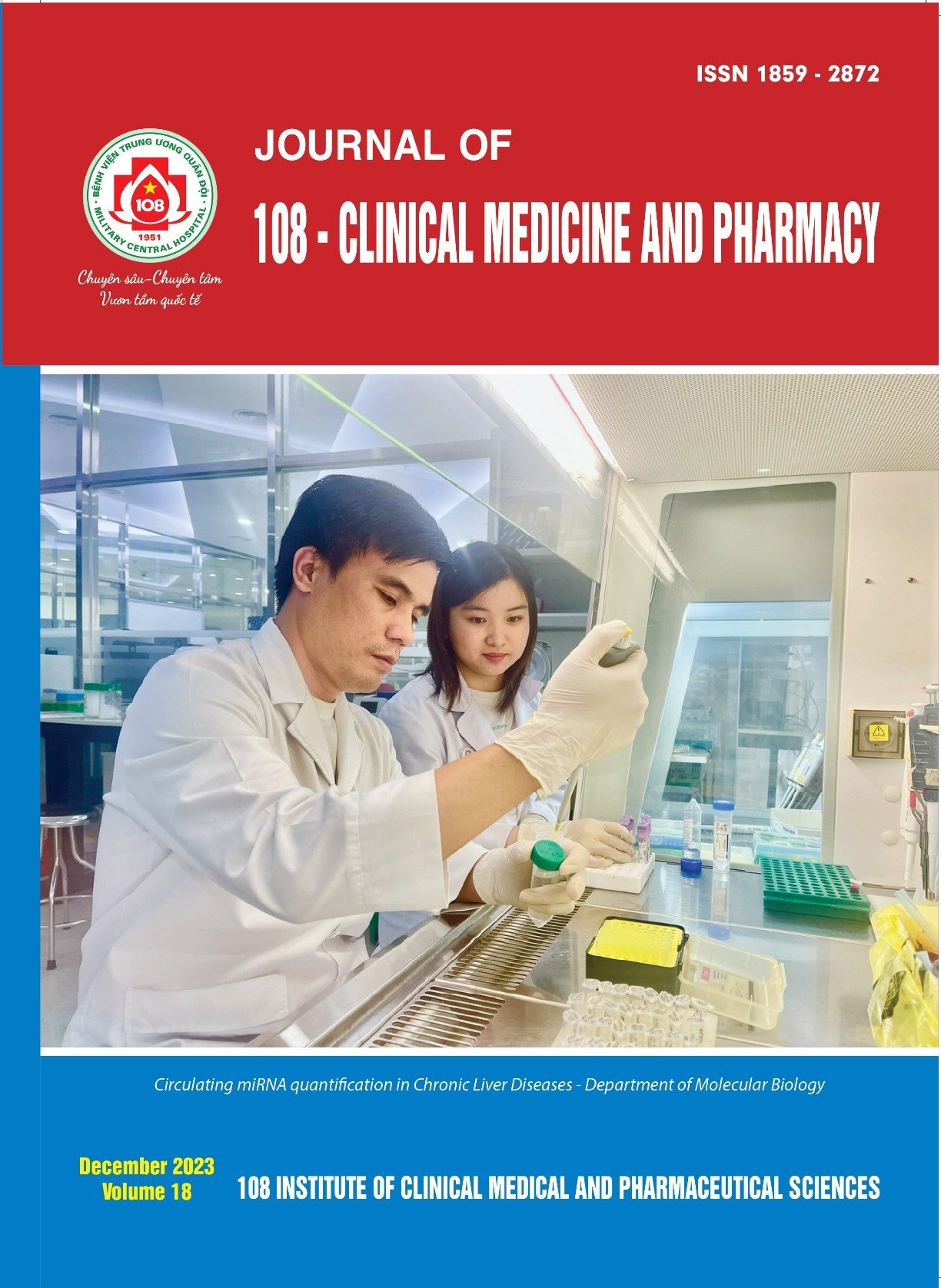D-dimer levels in young patients with ischemic stroke: A clinical report
Main Article Content
Keywords
Tóm tắt
Objective: This clinical report investigates the role of D-dimer in young ischemic stroke patients and its association with stroke severity assessed by the National Institutes of Health Stroke Scale (NIHSS) and functional outcomes evaluated using the modified Rankin Scale (mRS). Subject and method: We conducted a prospective study on 35 young patients (aged under 46) diagnosed with acute ischemic stroke at 108 Military Central Hospital in Ha Noi from October 2022 to April 2023. Each patient underwent thorough clinical evaluation, including a detailed medical history, physical examination, and neuroimaging studies. D-dimer levels were measured within 24 hours of admission using standard laboratory assays. The patients were divided into 2 groups according to mRS scores or NIHSS scores evaluated on the first day inhospital. Result: We observed that plasma D-dimer level correlated significantly with the prognosis of acute cerebral infarction (ACI) evaluated based on both mRS scores (1526.58 ± 1462.51ng/mL for poor prognosis versus 348.22 ± 201.14ng/mL for good prognosis, p<0.05) and NIHSS scores (1962.00 ± 1578.50ng/mL for poor prognosis versus 501.93 ± 663.10ng/mL for good prognosis, p<0.05). Conclusion: Our results demonstrated that there is a significant correlation between elevated D-dimer levels and worsened functional outcomes and increased mortality in young patients with acute ischemic stroke.
Article Details
Các tài liệu tham khảo
2. Ekker MS, Boot EM, Singhal AB et al (2018) Epidemiology, aetiology, and management of ischaemic stroke in young adults. Lancet Neurol 17(9): 790-801.
3. Haapaniemi E and Tatlisumak T (2009) Is D-dimer helpful in evaluating stroke patients? A systematic review. Acta Neurol Scand 119(3): 141-150.
4. Zhang J, Liu L, Tao J et al (2019) Prognostic role of early D-dimer level in patients with acute ischemic stroke. PLoS One 14(2):e0211458. doi: 10.1371/journal.pone.0211458.
5. Barber M, Langhorne P, Rumley A et al (2004) Hemostatic Function and Progressing Ischemic Stroke. Stroke 35(6): 1421-1425.
6. Goldstein M, Barnett H, Orgogozo JM et al (1989) Recommendations on stroke prevention, diagnosis, and therapy. Report of the WHO Task Force on Stroke and other Cerebrovascular Disorders. Stroke 20(10): 1407-1408.
7. Brott T, Adams HP, Olinger CP et al (1989) Measurements of acute cerebral infarction: a clinical examination scale. Stroke 20(7): 864-870.
8. Yuan B, Yang T, Yan T et al (2021) Relationships Between D-dimer Levels and Stroke Risk as Well as Adverse Clinical Outcomes After Acute Ischemic Stroke or Transient Ischemic Attack: A Systematic Review and Meta-Analysis. Front Neurol 12:670730. doi: 10.3389/fneur.2021.670730.
9. Urbach H, Hartmann A, Pohl C et al (2002) Local intra-arterial thrombolysis in the carotid territory: does recanalization depend on the thromboembolus type? Neuroradiology 44(8): 695-699.
10. Csala M, Léránt I, Bánhegyi G et al (1998) Prostaglandin-independent stimulation of interleukin-6 production by fibrinogen degradation product D in perfused murine liver. Scand J Immunol 48(3): 269-271.
11. Robson SC, Shephard EG, Kirsch RE (1994) Fibrin degradation product D-dimer induces the synthesis and release of biologically active IL-1 beta, IL-6 and plasminogen activator inhibitors from monocytes in vitro. Br J Haematol 86(2): 322-326.
12. Zhu A, Zhang J, Zou T et al (2014) [Associations of blood pressure, glucose or lipids with stroke in different age or gender]. Zhong Nan Da Xue Xue Bao Yi Xue Ban 39(12): 1271-1278.
13. Appelros P, Nydevik I and Viitanen M (2003) Poor outcome after first-ever stroke: Predictors for death, dependency, and recurrent stroke within the first year. Stroke 34(1): 122-126.
14. Sato T, Sato S, Yamagami H et al (2020) D-dimer level and outcome of minor ischemic stroke with large vessel occlusion. J Neurol Sci 413: 116814. doi: 10.1016/j.jns.2020.116814.
15. Bao Q, Zhang J, Wu X et al (2023) Clinical Significance of Plasma D-dimer and Fibrinogen in Outcomes after Stroke: A Systematic Review and Meta-Analysis. Cerebrovasc Dis 52(3): 318-343.
16. Zhang P, Wang C, Wu J et al (2021) A Systematic Review of the Predictive Value of Plasma D-dimer Levels for Predicting Stroke Outcome. Front Neurol 12: 693-524.
17. Nezu T, Kitano T, Kubo S et al (2018) Impact of D-dimer levels for short-term or long-term outcomes in cryptogenic stroke patients. J Neurol 265(3): 628-636.
18. Huţanu A, Iancu M, Bălaşa R et al (2018) Predicting functional outcome of ischemic stroke patients in Romania based on plasma CRP, sTNFR-1, D-Dimers, NGAL and NSE measured using a biochip array. Acta Pharmacol Sin 39(7): 1228-1236.
 ISSN: 1859 - 2872
ISSN: 1859 - 2872
